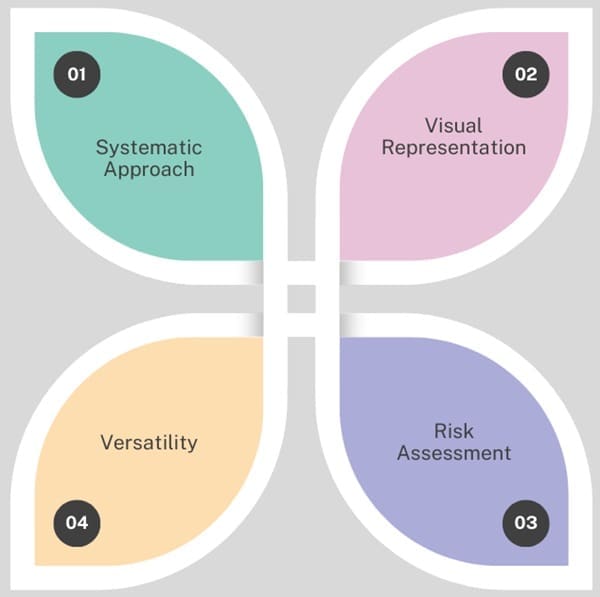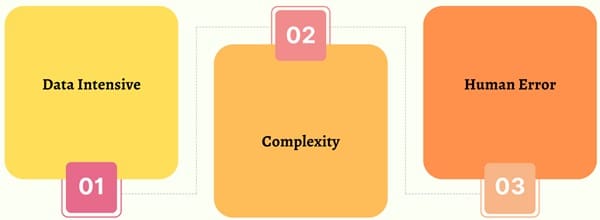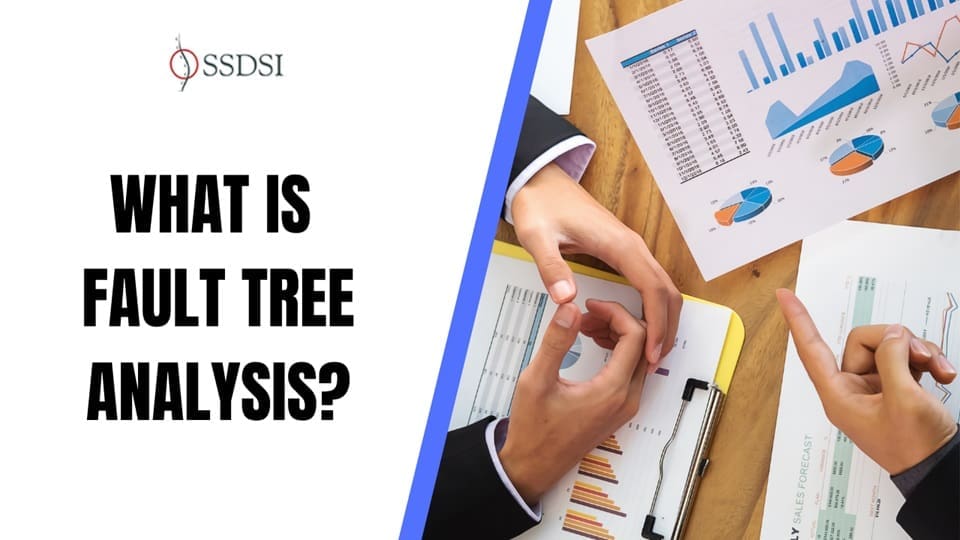Fault Tree Analysis (FTA) is a systematic, deductive method used to evaluate the causes of system failures and accidents. Fault Tree Analysis is widely used in engineering, safety, and risk management. It helps identify potential hazards and assess the reliability and safety of complex systems.
This method involves building a “tree” structure. The tree traces potential causes of a specific undesired event, known as the “top event.” The analysis identifies various component failures or human errors that could lead to this top event.
Fault Tree Analysis is essential for assessing risk. It helps identify weak points in systems and supports informed decisions to improve safety and reliability.
Table of contents
What is Fault Tree Analysis (FTA)?
At its core, Fault Tree Analysis (FTA) is a logical, top-down approach to understanding system failures. It begins with the top event—the undesired system state or failure that needs to be analyzed. From there, the analysis breaks down the possible causes of this event, identifying the component failures, environmental factors, and human errors that could lead to the top event.
The results of an FTA are typically represented in a diagram known as a fault tree, which is composed of various events and logic gates (such as AND, OR, and NOT gates) that connect these events. These gates define the logical relationships between events and help to show how a combination of failures might lead to a catastrophic system failure.
FTA is particularly useful because it allows for the identification of not just individual failures, but also combinations of failures that could occur in a system. By working from the top event down to the underlying causes, FTA provides a clear visualization of the complex interdependencies in a system.
Historical Background of Fault Tree Analysis
FTA was first developed in the early 1960s by Bell Telephone Laboratories. It was initially applied to analyze the safety of the Minuteman missile launch control system, a key part of the United States’ defense.
Boeing later refined FTA and expanded its use during the Reactor Safety Study (WASH-1400), which investigated nuclear reactor safety. The technique gained wide acceptance because it provides a structured way to identify potential causes of failure and assess risks in complex systems.
Over time, FTA evolved to include quantitative analysis methods. These methods enable the calculation of failure probabilities and help identify high-risk components within a system.
Key Components of Fault Tree Analysis

Fault Tree Analysis relies on the concept of “multi-causality.” This means that a single failure event can often have multiple contributing factors.
The most common elements in a fault tree diagram include:
- Top Event: The undesirable event or failure that is being analyzed. For example, it could be a system breakdown, a safety failure, or an accident.
- Basic Events: These are the root causes or failure conditions that are fundamental to the system. Basic events often represent component failures or human errors, and they are usually the simplest level of events.
- Intermediate Events: These events result from the combination of basic events and may represent more complex failures in the system.
- Logic Gates: These are the symbols used to connect events in a fault tree. They define the logical relationship between events, such as whether one event causes another or whether multiple events must occur simultaneously for a failure to happen. The most common gates include:
- AND Gate: All input events must occur for the output event to happen. For example, if both a pump failure and a valve failure occur, the system may fail.
- OR Gate: At least one of the input events must occur for the output event to happen. For example, if either a pump failure or a valve failure occurs, the system may fail.
- NOT Gate: The output event occurs when the input event does not happen.
- Minimal Cut Sets: These are the smallest sets of basic events that, if they all occur, will result in the top event. Identifying minimal cut sets is crucial for understanding which component failures are most critical in leading to the top event.
Steps Involved in Fault Tree Analysis

Fault Tree Analysis follows a structured set of steps to identify, assess, and quantify failure risks. The general process includes:
- Defining the System and Top Event: Begin by defining the system under analysis and identifying the top event. This event represents the undesirable outcome the analysis aims to prevent, like a safety system failure or catastrophic accident.
- Constructing the Fault Tree: After identifying the top event, break it down into its potential causes. Create a diagram that connects events with logic gates to show how they combine to trigger the top event. Start the diagram with the top event, branching down to detail intermediate and basic events until the root causes are clear.
- Identifying Minimal Cut Sets: With the fault tree constructed, identify the minimal cut sets. These are the smallest combinations of basic events that can cause the top event. Analyzing these cut sets helps engineers pinpoint failures with the most significant impact on system safety and reliability.
- Qualitative Analysis: Assess the fault tree’s structure without applying numerical values to event probabilities. The goal is to reveal critical failure points and understand how the interaction of events leads to the top event.
- Quantitative Analysis: Assign probability values to each basic event, using historical data, system characteristics, or expert judgment. This step calculates the probability of the top event, helping engineers evaluate the likelihood of failure and assess risks in different parts of the system.
- Reporting Results: Compile the results into a report, including the fault tree diagram, identified minimal cut sets, and quantitative risk assessment. This report helps stakeholders understand potential risks and prioritize mitigation efforts effectively.
Applications of Fault Tree Analysis
FTA is widely used in industries where safety and reliability are of utmost importance. Some of the key applications include:
- Aerospace: FTA is used to analyze the potential failure modes of complex systems such as spacecraft, satellites, and rockets. It helps ensure that systems are designed to minimize the risk of catastrophic failure.
- Nuclear Power: The nuclear industry uses FTA to assess the risk of accidents such as reactor meltdowns, radiation leaks, and system failures. By understanding the potential causes of such events, the industry can implement safety measures to reduce the likelihood of a disaster.
- Chemical and Petrochemical: FTA is used in chemical plants to analyze the causes of accidents such as explosions, fires, and toxic leaks. It helps identify weak points in the system and supports the design of better safety measures.
- Medical Devices: FTA is applied in the medical device industry to assess the failure risks of critical devices such as pacemakers, infusion pumps, and ventilators. This helps ensure that these devices are reliable and safe for patient use.
- Automotive: In the automotive industry, FTA is used to assess the risk of accidents or system failures in vehicles. This includes analyzing failure modes in complex systems such as braking, airbag deployment, and engine operation.
Advantages

- Systematic Approach: FTA provides a structured and logical method for identifying and analyzing the causes of system failures.
- Visual Representation: The fault tree diagram offers a clear, graphical representation of how events are related, making it easy to understand complex systems.
- Risk Assessment: FTA allows for the quantitative assessment of risk, helping organizations prioritize safety measures and resource allocation.
- Versatility: FTA can be applied to a wide range of industries and systems, from aerospace to healthcare.
Limitations

- Data Intensive: FTA requires accurate data for the probability of basic events, which may not always be available, especially in new or unique systems.
- Complexity: For large and complex systems, the fault tree can become extremely large and difficult to manage, making the analysis time-consuming and resource-intensive.
- Human Error: The effectiveness of FTA depends on the accuracy of the input data and the assumptions made during the analysis. Human errors in data collection or interpretation can lead to inaccurate conclusions.
Fault Tree Analysis vs. Event Tree Analysis
Fault Tree Analysis (FTA) focuses on identifying the causes of a failure, while Event Tree Analysis (ETA) examines the consequences after an event occurs. Used together, FTA and ETA form a “bow-tie” model. FTA helps pinpoint the root causes, and ETA analyzes how the event will progress and what actions can contain or reduce its impact.
For instance, in the case of a fire in a facility, FTA would identify the failures that led to the fire, like a faulty detection system or a broken valve. ETA would then assess what happens next, such as if the sprinkler system activates and whether emergency procedures work effectively.
Final Words
Fault Tree Analysis is a powerful tool for identifying and understanding the causes of system failures. By breaking down complex events into smaller, manageable components, FTA helps engineers, safety professionals, and risk analysts assess the likelihood of failure and implement measures to prevent accidents.
Whether used in aerospace, nuclear power, chemical plants, or healthcare, FTA remains a critical technique for ensuring the reliability and safety of complex systems. However, like any analytical tool, its effectiveness depends on accurate data and a thorough understanding of the system being analyzed.

About Six Sigma Development Solutions, Inc.
Six Sigma Development Solutions, Inc. offers onsite, public, and virtual Lean Six Sigma certification training. We are an Accredited Training Organization by the IASSC (International Association of Six Sigma Certification). We offer Lean Six Sigma Green Belt, Black Belt, and Yellow Belt, as well as LEAN certifications.
Book a Call and Let us know how we can help meet your training needs.



















